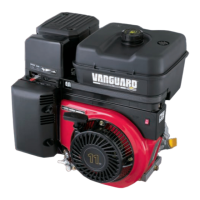GB
2
WARNING
Fuel and its vapors are extremely flammable and
explosive.
Fire or explosion can cause severe burns or death.
WHEN ADDING GASOLINE
• Turn engine OFF and let engine cool at least 2
minutes before refueling engine.
• Fill fuel tank outdoors or in wellĆventilated area.
• Do not overfill fuel tank. Fill tank to approximately
1Ć1/2 inches below top of neck to allow for fuel
expansion.
• Keep gasoline away from sparks, open flames, pilot
lights, heat, and other ignition sources.
• Check fuel lines, tank, cap, and fittings frequently
for cracks or leaks. Replace if necessary.
WHEN STARTING ENGINE
• Make sure spark plug, muffler, fuel cap and air
cleaner are in place.
• Do not crank engine with spark plug removed.
• If fuel spills, wait until it evaporates before starting
engine.
• If engine floods, set choke to OPEN/RUN position,
place throttle in FAST and crank until engine starts.
WHEN OPERATING EQUIPMENT WITH
GASOLINE ENGINE
• Do not tip engine or equipment at angle which
causes gasoline to spill.
• Do not choke carburetor to stop engine.
WHEN TRANSPORTING EQUIPMENT
• Transport with fuel tank EMPTY or with fuel shutĆoff
valve OFF, and/or fuel cylinder empty.
WHEN STORING FUEL OR EQUIPMENT
• Store away from furnaces, stoves, water heaters or
other appliances that have pilot light or other ignition
source because they can ignite gaseous vapors.
WARNING
• When starting engine, pull cord slowly until
resistance is felt, then pull rapidly.
• Remove all external equipment/engine loads
before starting engine.
• Direct coupled equipment components such as, but
not limited to, blades, impellors, pulleys, sprockets,
etc., must be securely attached.
Rapid retraction of starter cord (kickback) will pull hand and
arm toward engine faster than you can let go.
Broken bones, fractures, bruises or sprains could result.
• Operate equipment with guards in place.
• Keep hands and feet away from rotating parts.
• Tie up long hair and remove jewelry.
• Do not wear looseĆfitting clothing, dangling
drawstrings or items that could become caught.
Unintentional sparking can result in fire or electric shock.
Unintentional startĆup can result in entanglement, trauĆ
matic amputation, or laceration.
BEFORE PERFORMING ADJUSTMENTS OR REĆ
PAIRS
• Disconnect spark plug wire and keep it away from
spark plug.
• Disconnect battery at negative terminal (only
engines with electric start).
WHEN TESTING FOR SPARK
• Use approved spark plug tester.
• Do not check for spark with spark plug removed.
WARNING
Engines give off carbon monoxide, an odorless, colorless,
poison gas.
Breathing carbon monoxide can cause nausea, fainting or
death.
• Start and run engine outdoors.
• Do not start or run engine in enclosed area, even if
doors or windows are open.
WARNING
• If there is natural or LP gas leakage in area, do not
start engine.
• Do not use pressurized starting fluids because
vapors are flammable.
• Servicing of products fueled by Natural Gas (NG) or
Liquid Petroleum Gas (LPG) may require licensing
or permits issued by state, provincial, and/or local
governments.
WARNING
Starting engine creates sparking.
Sparking can ignite nearby flammable gases.
Explosion and fire could result.
WARNING
Rotating parts can contact or entangle hands, feet, hair,
clothing, or accessories.
Traumatic amputation or severe laceration can result.
Running engines produce heat. Engine parts, especially
muffler, become extremely hot.
Severe thermal burns can occur on contact.
Combustible debris, such as leaves, grass, brush, etc. can
catch fire.
• Allow muffler, engine cylinder and fins to cool before
touching.
• Remove accumulated combustibles from muffler
area and cylinder area.
• Install and maintain in working order a spark
arrester before using equipment on forestĆcovered,
grassĆcovered, brushĆcovered unimproved land.
The state of California requires this (Section 4442 of
the California Public Resources Code). Other
states may have similar laws. Federal laws apply on
federal land.
WARNING
WARNING
IF YOU SMELL LPG / NG GAS:
• DO NOT start the engine.
• DO NOT actuate any electrical switches.
• DO NOT use the phone in the vicinity.
• Evacuate the area, LPG / NG gas is a toxic fume.
• Contact the gas supplier or fire department.
REMEMBER:
• LPG vapor is heavier than air and trends to collect in
low areas. NG vapor is lighter than air and tends to
collect in high areas. Both may travel to remote
locations.
• Keep all flames, sparks, pilot lights, and other
ignition sources away from the area where the
engine is operated or repaired.
• DO NOT smoke when operating or repairing the
engine.
• DO NOT store gasoline or other flammable vapors
or liquids in the vicinity of the engine.
• BEFORE doing any service work to the engine,
shut off the gas supply.
• After initial installation or servicing, check for gas
leaks. DO NOT use an open flame. Apply very
soapy water or leak test solution with a brush and
look for bubbles.
• Keep the area surrounding the engine and
equipment it powers free of debris.
• Install the fuel system according to applicable
fuel/gas codes.
• Check fuel supply lines regularly for cracks or wear.
Replace if damaged.
Gaseous fuels are extremely flammable and readily form
explosive airĆvapor mixtures at ambient temperatures.

